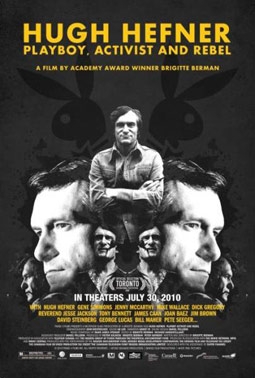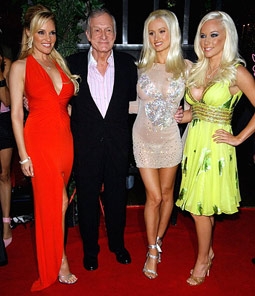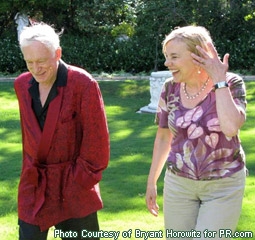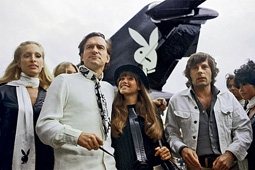




Sex, beautiful women, flirtatious Bunnies, and Playboy Magazine bring an immediate image: Hugh Hefner. Academy Award winning director Brigitte Berman’s new documentary, Hugh Hefner: Playboy, Activist, and Rebel, breaks through Hugh Hefner’s barricade of arm candy to reveal an intimate portrait of a man misunderstood.

Berman told me, “I wanted to really open up the eyes of many people about this man who has many sides. He is not the devil, or as some may call him, a pornographer. I think his influence on America, in so many ways, has been tremendous. His life has intersected with many Americans about many issues.”

The film portrays Hugh Hefner as a champion of civil rights, women’s rights, and an advocate of freedom of speech. I was astounded by his involvement in Vietnam War protests, his embrace of black listed musicians and writers during McCarthyism, and his unrelenting acceptance of African-American comedians and performers at a time when segregation reigned. Who knew that good old “Hef” with his plethora of pretty blondes in a Mansion of plentitude had such strong political and social convictions?

Gene Simmons opens the movie: “Show me any guy, any time in history who wouldn’t give his left nut to be Hugh Hefner.” The film focuses on candid, engaging interviews from enemies and friends including Tony Bennett, George Lucas, and Joan Baez, to name a few. Singer Pat Boone and outspoken feminist Susan Brownmiller led the opposing viewpoints. “He’s objectifying women and breaking the moral fibers of our society,” Boone proclaims.

Brigitte Berman crafted the film in an unbiased way, including fierce opposing viewpoints and film clips where Hugh Hefner is attacked by feminists and conservative talk show hosts. The criticism is padded with interviews from people who respect and greatly admire Hugh Hefner as a creative genius. “He thought big and creatively wherever he went,” his brother, Keith Hefner, shares.

George Lucas equates his job to Hefner’s and adds, “Half the fantasies [Hefner and I] create already exist in people’s minds; we are just helping them out.”
Hugh Hefner: Playboy, Activist, and Rebel intersperses interviews, old television clips, and photos with cartoon characters that act out Hugh Hefner’s past. Though bringing another element to the documentary, the cartoons feel a bit forced and contrast sharply with the truthful, expressive interviews in the film. Berman asks, “How much can you open up the people you are talking to? I think that is always the heart of a documentary.” The film could have easily stood alone without the cartoons; the candidness and passion of those interviewed keep the documentary interesting.”
Though involved in a world of sex and entertainment, Hefner shows a genuine passion for the people in his life. “Hefner’s integrity and his longstanding friendships really surprised me. People you saw early on in the scrapbook, you see them throughout. Ex-girlfriends reappear and remain his friends,” Berman says.
During the footage from his 50th birthday celebration, a friend gives a heartwarming speech as Hugh Hefner’s face lights up in genuine contentment. I appreciated the constancy of Hefner’s character; his underlying personality and charm never seem to waver. Despite fame, fortune, and a backyard full of roaming peacocks and other rare animals (the Playboy mansion holds a zoo permit), Hefner favors a robe and pajamas to his closet full of designer duds. He worked hard for what he has achieved and truly seems to value close connections and friendships above all else.
For more than three years and with complete creative control, Brigitte Berman conducted all of the interviews and research for Hugh Hefner: Playboy, Activist, and Rebel. Hefner shared his treasure trove of scrapbooks and memoirs dating back to his very first Playboy issue, with the unforgettable cover shot of Marilyn Monroe and that famous never-before-seen nude photograph of Marilyn Monroe that launched Playboy Magazine back in 1953.
In the 1950’s, Hugh Hefner felt stifled in his job as an advertising salesman for a children’s magazine and unhappy in his marriage. Unwilling to accept the Puritan lifestyle his parents thrust upon him while growing up in Chicago, he created Playboy Magazine. Playboy satisfied his craving to push social buttons and to soften society’s rigid attitudes about sex.
Brigitte Berman, a Canadian Oscar winning filmmaker and writer wanted the movie to be thought-provoking in a way that encourages the viewer to shape a personal opinion of Mr. Hefner. Berman discusses, “I wanted to make a balanced film that would look at all sides and that would present interesting complexities. This will let the audience think for themselves, and decide what they think about Hefner. In the end, it’s up to each person.”
I gained a great sense of admiration and awe for Hugh Hefner. He pushed societal and creative boundaries and placed controversial articles into his magazine. For example, Hefner gave Ray Bradbury a chance to publish installments of Fahrenheit 451 when other publishers rejected his work. He included a profile of Charlie Chaplin in Playboy Magazine when the government black listed him. Hefner also used his television shows, Playboy After Dark and Playboy’s Penthouse, as platforms, allowing performers – often ones who society refused to appreciate due to their race or political views – the chance to share their voices.
“I courted controversy,” Hugh Hefner admits in the film. “Controversy is the way you change things.”
Hugh Hefner: Playboy, Activist, and Rebel, in theaters July 30th, opens coincidentally at a time when Hefner’s attempt to buy back Playboy and transform it into a privately held company once again is making news. Hefner clearly takes pride in the empire he has created. In this documentary, he easily dismisses a proposed layout change to the magazine. “The magazine should be an old friend,” Hefner says.
Today, Playboy’s pages do not shock the general public as they once did in the 1950’s. That is precisely the value of this new documentary – how easily we forget the days when African-American musicians could not take the stage to perform before white audiences. Women had little access to equal employment and no access to contraceptives. Hugh Hefner paved the way for these important social changes that we now take for granted.
Hugh Hefner: Playboy, Activist, and Rebel presents a side of Hugh Hefner truly worth knowing. Director and producer Brigitte Berman says, “There’s this extremely interesting, and I find, far more sexy side to him. That’s what I wanted to bring out with this film.”
“Hugh Hefner: Playboy, Activist and Rebel” is now playing in theatres in select cities. Visit hughhefnerplayboyactivistrebel.com.
